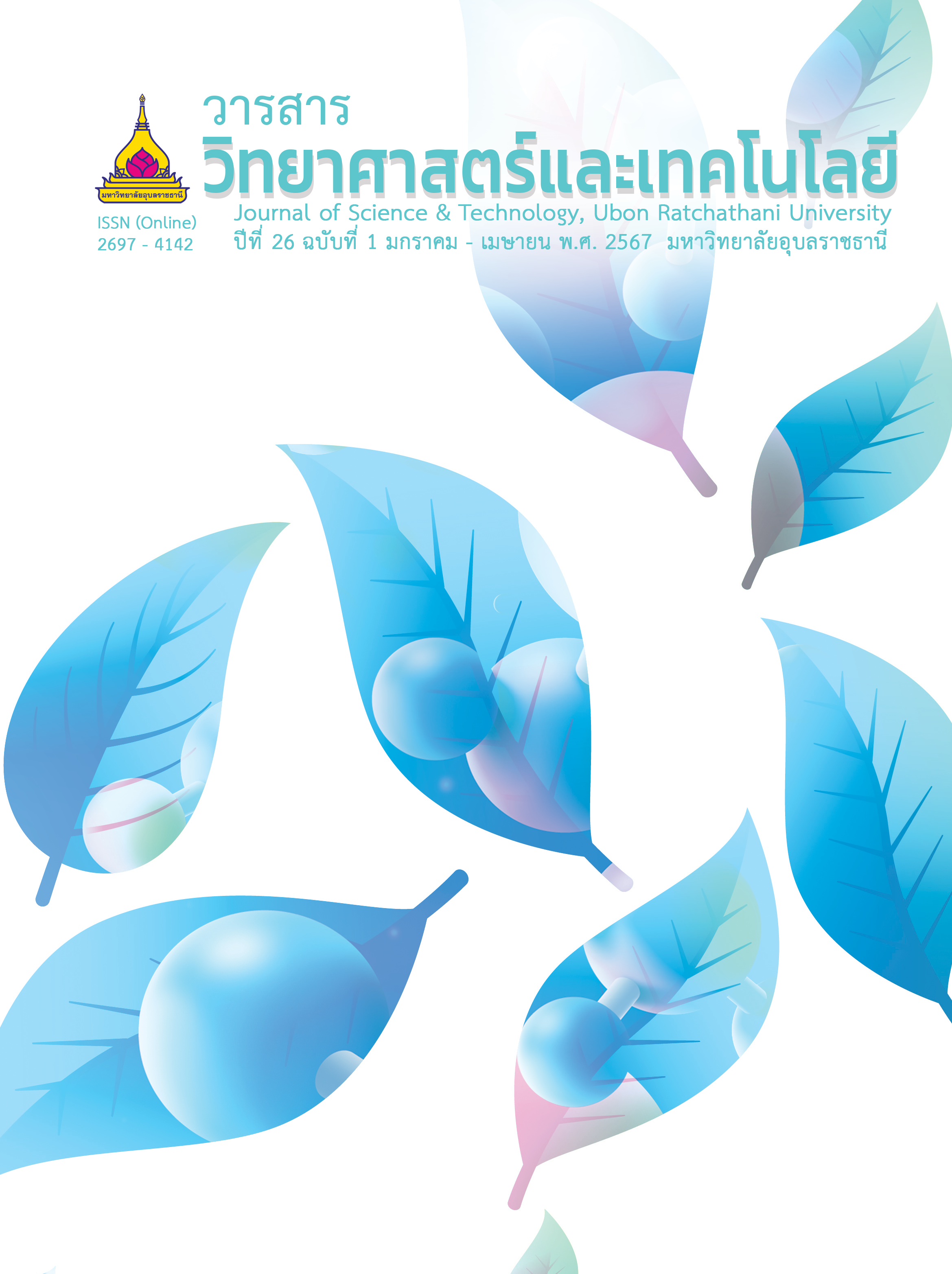การผลิตกระถางต้นไม้ย่อยสลายจากปุ๋ยหมักกากขี้แป้ง
Main Article Content
บทคัดย่อ
งานวิจัยนี้มีวัตถุประสงค์เพื่อพัฒนากระถางต้นไม้ย่อยสลายจากปุ๋ยหมักกากขี้แป้ง โดยศึกษาส่วนผสมที่เหมาะสมในการผลิตกระถางต้นไม้ย่อยสลาย และประเมินความคุ้มค่าทางเศรษฐศาสตร์ของผลิตภัณฑ์ ปุ๋ยหมักกากขี้แป้งที่ใช้ในการศึกษานี้ทำโดยหมัก กากขี้แป้งที่ได้จากโรงงานน้ำยางข้นกับมูลวัวเป็นเวลา 50 วัน ในการผลิตกระถางต้นไม้ย่อยสลายแบ่งการทดลองออกเป็น 4 ชุด การทดลองที่มีส่วนผสมของปุ๋ยหมักกากขี้แป้ง : ดินลำดวน : ดินร่วน ที่แตกต่างกัน คือ 100:0:0, 75:20:5, 50:40:10 และ 25:60:15 โดยน้ำหนัก กาวแป้งเปียกที่ใช้ประสานในการขึ้นรูปกระถางต้นไม้ใช้แป้งมันสำปะหลังผสมกับน้ำเปล่าในอัตราส่วน 1:10 สมบัติของกระถางต้นไม้ย่อยสลายที่พิจารณา ได้แก่ ลักษณะทางกายภาพ การดูดซับน้ำ การพองตัว ความพรุน และการเสื่อมสภาพ ผลการศึกษาพบว่ากระถางต้นไม้ย่อยสลายที่มีค่าการดูดซับน้ำ ค่าการพองตัว ค่าความพรุน สูงที่สุด และมีการเสื่อมสภาพช้าที่สุด คือ กระถางที่มีอัตราส่วนของปุ๋ยหมักกากขี้แป้ง : ดินลำดวน : ดินร่วน ที่เท่ากับ 25:60:15 ในการประเมินผลกระทบทางเศรษฐกิจ พบว่าผลตอบแทนจากการลงทุนในการผลิตกระถางต้นไม้ย่อยสลาย เท่ากับ 65.84 และมีกำไรสุทธิเฉลี่ย เท่ากับ 7.94 บาท/ใบ การศึกษานี้เสนอแนวทางที่นอกจากเป็นการเพิ่มมูลค่าของกากขี้แป้งแล้ว ยังเป็นการช่วยลดปัญหามลพิษสิ่งแวดล้อม และลดค่าใช้จ่ายในกำจัดของเสียด้วย
Article Details

อนุญาตภายใต้เงื่อนไข Creative Commons Attribution-NonCommercial-NoDerivatives 4.0 International License.
บทความที่ได้รับการตีพิมพ์เป็นลิขสิทธิ์ของ วารสารวิทยาศาสตร์และเทคโนโลยี มหาวิทยาลัยอุบลราชธานี
ข้อความที่ปรากฏในบทความแต่ละเรื่องในวารสารวิชาการเล่มนี้เป็นความคิดเห็นส่วนตัวของผู้เขียนแต่ละท่านไม่เกี่ยวข้องกับมหาวิทยาลัยอุบลราชธานี และคณาจารย์ท่านอื่นๆในมหาวิทยาลัยฯ แต่อย่างใด ความรับผิดชอบองค์ประกอบทั้งหมดของบทความแต่ละเรื่องเป็นของผู้เขียนแต่ละท่าน หากมีความผิดพลาดใดๆ ผู้เขียนแต่ละท่านจะรับผิดชอบบทความของตนเองแต่ผู้เดียว
เอกสารอ้างอิง
Rubber Intelligence Unit. 2015. Concentrated Latex. http://rubber.oie.go.th/Elibrary.aspx?cid =1140. Accessed 25 February 2023. (in Thai)
Kaewthai, S., Puangmanee, S. and Taweepreda, W. 2019. The effect of field natural rubber latex pretreatment with cationic exchange resin on latex dipped film properties. Journal of Rubber Research. 22: 91-98.
Kowutthikulrangsee, S. and et al. 2010. Processing of Starch Waste from Concentrated Latex Industry and Its Uses. Research report, Prince of Songkla University. (in Thai)
Tekprasit, V. 2000. The Utilization of the Centrifuged Residue from Concentrated Latex Industry as a Soil Conditioner. M.Sc. Thesis, Prince of Songkla University. (in Thai)
Loykulnan, S. and Kongkaew, C. 2012. Process of Separation of Rubber and Inorganic Substances from Natural Latex Sludge (GRASS 3). Bangkok: National Science and Technology Development Agency. (in Thai)
Chirawatthanachai, C. 2001. Opinion of Farmers towards the Future of Potted Planting in Ongrak District. M.Sc. Thesis, Kasetsart University. (in Thai)
Verma, R. and et al. 2016. Toxic pollutants from plastic waste - A review. Procedia Environmental Sciences. 35: 701-708.
Chamas, A. and et al. 2020. Degradation rates of plastics in the environment. ACS Sustainable Chemistry and Engineering. 8: 3494-3511.
Schettini, E. and et al. 2013. Recycled wastes of tomato and hemp fibres for plant pots: Physico-chemical characterization and field performance. Resources, Conservation and Recycling. 70: 9-19.
Evans, M.R. and et al. 2004. Properties of plastic, peat, and processed poultry peather fiber growing containers. HortScience. 39(5): 1008-1011.
Candido, V., Castronuovo, D. and Miccolis, V. 2011. The use of biodegradable pots for the cultivation of poinsettia. Acta Horticulturae. 893: 1147-1154.
Jitpiromsri, S. 1996. A study on the Utilization of Sawdust from Mushroom Cultivation for Potted Planting Material. M.Sc. Thesis, Mahidol University. (in Thai)
Danso, H. and Manu, D. 2020. Influence of coconut fibres and lime on the properties of soil-cement mortar. Case Studies in Construction Materials. 12(1): 15-16.
Piyang, T. and et al. 2018. Environment-friendly plant pot production from palm oil sludge and mushroom cultured waste. Rajamangala University of Technology Srivijaya Research Journal. 10(3): 497-511. (in Thai)
Chaisupakitsin, M. and et al. 2010. Properties of fiberboard made from coconut coir/polystyrene foam containing flame retardant. Burapha Science Journal. 15(2): 57-66. (in Thai)
Somakul, P. and Ngencharoen, S. 2020. Biodegradable nursery pot from beverage labeling waste and coconut bagasse. In: Proceedings of the 4th KU SRC Annual Conference, 28 August 2020. Chonburi, Thailand. (in Thai)


